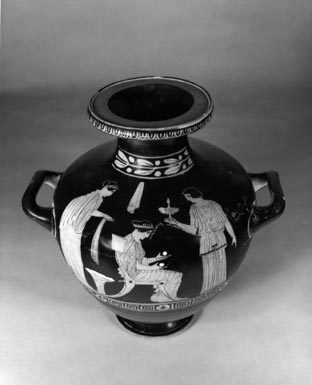Items Exhibited:
Red–Figured Hydria
Attica, 450–440 B.C.; the Christie Painter
Clay
Collection of Glencairn Museum
Baby-feeder
Greek, 4th century B.C.
Terracotta
The Art Museum, Princeton University. Gift of Allan Marquand, Class of 1874.
Ancient Loomweight
Clay
The Art Museum, Princeton University. Gift of Allan Marquand.
Greek Loomweight
Clay
The Art Museum, Princeton University. Gift of Allan Marquand.
Ancient Spindle Whorl
Clay
The Art Museum, Princeton University. Gift of Mrs. Allan Marquand.
Spindle Whorl
Ancient Cypriote, 6th – 5th centuries B.C.
Clay
The Art Museum, Princeton University. Museum purchase.
Key
Medireview, Byzantine, 4th – 7th centuries A.D.
Bronze
The Art Museum, Princeton University. Unrecorded acquisition.
Key
Roman, 1st – 2nd centuries A.D.
Bronze
The Art Museum, Princeton University. Museum purchase.
Jointed Doll
Greek, mid 5th century B.C.
Terracotta
The Art Museum, Princeton University. Museum purchase and exchange.
Chair
Loaned by the University of Pennsylvania Museum of Archaeology and Anthropology.
Vase
Greek, Late 5th c. B.C.
Ceramic
Collection of The Newark Museum, Gift of Robin Beningson, 1997
Steelyard Beam
Rome, 1st – 2nd century A.D.
Bronze
Collection of The Newark Museum, Purchase 1994 Sophronia Anderson Bequest Fund
Bust
Roman, Prob. Late 3rd Century A.D.
Bronze
Collection of The Newark Museum, Eugene Schaefer Collection
Lamp
Italy, 20th C
Clay
Collection of The Newark Museum, Purchase 1924 The Newark Museum
|






